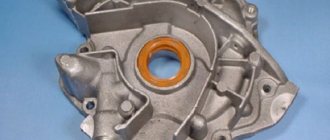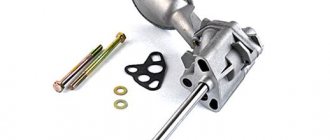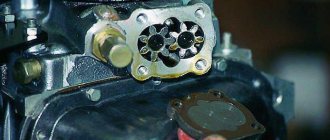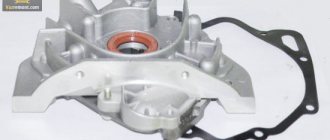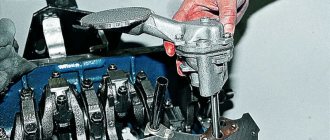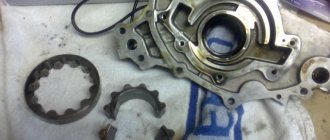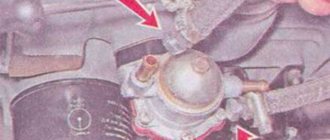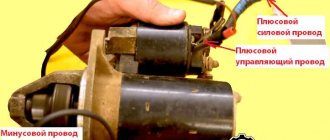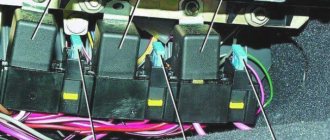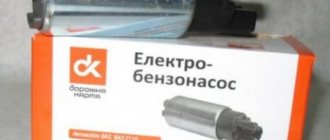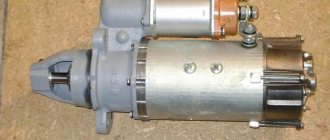Device
The frame on which the body is attached has 6 or 7 transverse beams (here an additional one was welded on, due to necessity). A front axle made of steel is fixed in front of the frame on two springs. At the ends of the front axle there are steering knuckles, where the wheels are attached using axles. The front wheels are single, with telescopic shock absorbers. The rigid frame of the truck is reinforced at the rear with a drive axle beam. There are springs on both sides. They are semi-elliptical and connected to the frame.
Between the frame and the springs there is a so-called rubber cushion. In addition, the rear suspension has additional springs. The rear wheels of this vehicle are double (two wheels on each side), for better maneuverability and stability. A well-thought-out shock absorption system allows the car to drive at a decent speed over all sorts of bumps on a dirt road without any consequences for the car.
A tug is attached to the back of the car, at the end of the frame. The spare wheel is mounted on the left. It was for its forethought in all cases that people in rural areas fell in love with this car. Cranes were even made on the basis of this machine: the body was removed, the rigid frame was strengthened with cross members, and the Gas 53 crane was bolted onto the chassis frame. In villages you can see these rarities of technology. They are still working.
Check the pump in 5 minutes
To check the GAZ 53 oil pump, just remove it from the engine, screw on the pressure gauge and put it in a bucket of oil. When scrolling with a screwdriver, you can only simulate idle speed (800 rpm with the required 1500 rpm), so it is better to take a drill.
We recommend watching: Checking the operation of the oil pump on a GAZ-53.
In field conditions, without a pressure gauge and a screwdriver, it is enough to immerse the oil receiver in a container with oil and turn it by hand. If there is a strong stream of oil, then everything is fine.
It is important to remember that very often the cause of poor pressure in the system is not the GAZ 53 oil pump, but the pressure reducing valve, which either does not work or is constantly open and reduces the overall pressure in the system. Its operation is regulated by special washers of different thicknesses, of which there are usually two (one slightly thicker, the other thinner).
Specifications
The Zavolzhsky Motor Plant 53 engine has the following characteristics:
- This motor is installed on the following trucks: GAZ 3307, 3308, GAZ 53 and PAZ 3205 passenger bus.
- Active use of the 53 model engine began back in 1966 on the main trucks of that time, GAZ 52 and GAZ 53A.
- Its main difference from previous models of engines from ZMZ is the overhead valve arrangement and the updated model of the K 126B carburetor, which after some time was replaced by the K 135.
- If you compare this model with the ZMZ 41, you can notice a decrease in the main technical characteristics, but at the same time the engine is characterized by reduced fuel consumption.
Also, the ZMZ 53 model is distinguished by a reduction in cylinder volume and piston stroke.
This indicates a structural difference between engine 53 and ZMZ 41. Therefore, the opinion that parts from the predecessor of the above-mentioned engine are interchangeable is erroneous. If we talk about the difference in cylinder blocks, then it lies in the different diameters of the seat for the liners, which prevents their direct replacement. But at the same time, no one bothers you to change one motor for a second, in which case there will be no problems with the compatibility of the motor and the car.
One of the best advantages of this engine is considered to be its safety margin and ease of operation, maintenance and repair. Mainly the good condition of the engine depends on the use of the correct grade of fuel. If you use the recommended type of gasoline, repair costs will be significantly reduced.
Also, with timely replacement of the lubricating fluid, the machine owner does not have to worry about the frequent formation of carbon deposits on the cylinder walls and pistons, which over time lead to more serious malfunctions. Also, during maintenance, it is necessary to check for the formation of carbon deposits, and if it is detected, the engine elements should be thoroughly cleaned. This will help increase the service life of the engine.
Another nuance, the observance of which will help to cope with malfunctions, is the timely tightening of the cylinder head. This advice is especially relevant for new cars, since during the first three inspections the need to tighten the cylinder head is quite high, but over time this procedure can be carried out once every 2 inspections.
Modifications
For more than 30 years of production of the 53rd model engine, the Zavolzhsky Plant has designed and created many different modifications for both GAZ cars and PAZ buses. Basically, they improved some of the parameters of the car, and also increased the list of equipment on which this engine could be installed.
Refill containers and standards
Content
2. Tactical technical characteristics of the car Gas - 53A…………
3. Main parameters and transmission diagram of the Gas - 53A car........
3.1. Purpose of the transmission and its general data …………………………
4.1 Traction calculations and dynamic characteristics………………………
4.2 Calculation of power balance, base vehicles during straight-line movement on a horizontal section of the track in direct (overdrive) gear…………………………………………………………………………………………
Introduction
One of the most common cars in Russia, the GAZ-53, can still be found on the streets of our cities. Whatever kind of work this truck performed, the machine found application in various spheres of the country’s national economy. Utility vehicles, fire trucks, agricultural machinery and much more were built on its basis.
Engine 53 model ZMZ: characteristics, malfunctions and tuning
One of the most popular engines for trucks in the Soviet Union is the ZMZ 53. This engine was in production for more than 30 years and ceased production in 1993.
This engine was mainly used for the GAZ 53 car, on which engines from the Gorky Automobile Plant were also installed. Subsequently, trucks from this manufacturer used exclusively Zavolzhsky Motor engines class=”aligncenter” width=”524″ height=”379″[/img]
Specifications
Gas 53 weighs 3 tons 250 kg. and has the following parameters:
- from the front bumper to the rear side - 6 m. 40 cm;
- from the left side to the starboard side - 2 m. 38 cm;
- height – 2 m. 22 cm;
- can carry a load of 4 tons;
- clearance from bottom to soil – 26.5 cm;
- the distance between the front and rear wheels is 3.7 meters;
- steel wheel rims;
- the distance between the front wheels is 1 meter 63 cm;
- the tank holds 90 liters of gasoline;
- dry disc clutch, driven by a lever.
The machine has drum brakes with a hydraulic booster.
Characteristics of the Gas 53 engine
Two brands of engines were installed on this car. On later ones, the movers are more powerful. Since 1966, the base vehicle has been equipped with the ZMZ 53 engine, which has the following parameters:
- gasoline, carburetor type;
- six-cylinder, four-stroke;
- engine capacity Gas 53 – 4.25 l.;
- weight – 265 kg;
- A-76 gasoline is used;
- compression ratio – 7.6;
- oil reserve – 10 liters;
- engine power Gas 53 – 115 hp;
Technical characteristics of the ZMZ 53 engine
may vary slightly between models.
The difference is insignificant. The Gas 53 engine brand could only affect cargo transportation and a little on speed. The valves are located at the top. The cylinder block and cylinder head are made of aluminum alloys. Photo of the Gas 53 engine:
The cabin is spacious. In addition to the driver, 2 more people can fit. The one-piece seat spans the entire width of the cabin and has a soft backrest. Metal frame of the cabin with two doors - left and right.
Fuel consumption
At 100 km. On the way, approximately 27 to 30 liters of gasoline are consumed, depending on the load.
Advantages and disadvantages
The truck has many positive characteristics. Easy to drive and reliable car. Repairs can be made under any conditions. Spare parts for the car are available. The truck can run up to 400 thousand km. without major repairs. There are also disadvantages. The weak point is the brakes, clutch assembly. They fail more often than other components. Distributor, cardan, shaft - their connection points may fail. In the engine, the main bearing may have a leaking seal.
First, a little history. The domestic medium-tonnage truck GAZ-53 (popularly called “GAZon”) is known to many car enthusiasts. Of course, it was this model that was used in a wide variety of sectors of the economy during the Soviet Union. The history of this truck dates back to 1961. It was then that a new medium-duty truck rolled off the Gorky assembly line for the first time. From then until today, these cars have not lost popularity.
But still, its units do not last forever, and sooner or later every GAZon owner is faced with such a problem as repair. As practice shows, this part breaks down once a year. Of course, this is a very short period for today's market, given that today's trucks must deliver goods smoothly at all times. But still, over such a long period of existence, the owners have found several ways to put the GAZ-53 aside for an indefinite period (that is, to extend its life).
In order for the motor to last as long as possible, you must always carefully monitor the technical serviceability of this unit, and if problems are detected, fix them. Which spare parts need to be checked? Now we'll figure it out.
Particular attention should be paid (this part is also marked with the abbreviation cylinder head). If necessary, tighten the mounting bolts and periodically clean the pistons from any deposits that have arisen. Also, do not neglect the cooling system.
The use of high-quality fuel and lubricants will certainly extend the life of the unit, and the GAZ-53 engine will last at least 2 times longer. Of course, it is quite difficult to find high-quality gasoline at our gas stations, but there is another way - installing methane-type gas equipment. Due to its properties, gas does not leave large deposits in the GAZ-53 engine, since there are more than 100 of it (and its price is several times less than gasoline). By the way, if you do not clean the internal combustion engine from carbon deposits in time, the truck will consume much more fuel and at the same time drive poorly.
As for the choice of oils for the GAZ-53 engine, it is better to trust imported manufacturers. Of course, not everyone will decide to pour expensive Mobil 1 or Castrol oil into a regular GAZon, but there is simply no other option.
Also, for an increased service life, the GAZ-53 engine must have only serviceable bearing shells. And it is quite easy to determine their malfunction - just look at it. If the arrow is below the 100 kilopascal mark, this indicates that one of the above parts needs to be replaced.
So, so that repairs of GAZ-53 engines are not required every year, you need to fill only high-quality oil into the engine, do not put off replacing rings and bearings until later, promptly clean the system from carbon deposits and, if possible, contact a service station with a request to install gas equipment on your truck. Rest assured - “GAZON” will thank you with long and continuous engine operation!
